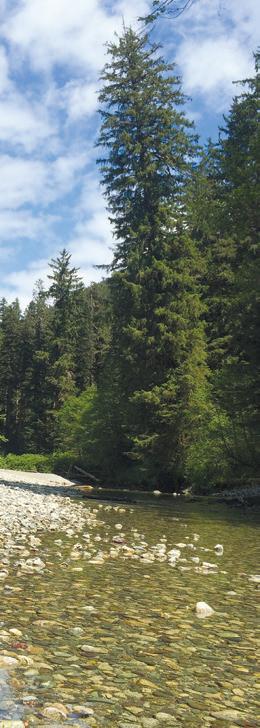
3 minute read
Forest bathing
Visiting our tall, quiet friends along the north Pacific
Treebeard has nothing to say.
Advertisement
Typical Ent.
Tolkien would be delighted. The British author’s famous anthropomorphic old growth trees from “Lord of the Rings” are fictional, of course, and notoriously taciturn. Well, maybe. There are innumerable huge, rugged, arboreal ancients between Alaska and California, and they emit enchantment and power like botanical wizards. That may not be verbal output but it is palpable and strong. Tolkien simply uncovered a natural phenomenon that outdoors people can experience for themselves in bigtree land.
How do I know that? I go see them.
The tree I am visiting today is my exact image of an Ent, and as Treebeard is the oldest and grandest of them all in Middle-earth, the venerable being before me deserves to represent the oldest and grandest Ent. This is the biggest black cottonwood in America — maybe the biggest cottonwood on Earth, never mind Middle-earth — and it’s in Oregon, south of Portland, along Willamette Mission State Park’s namesake river.
It stands 155 feet tall and measures 29 feet around its waist — 9 feet across. Its arms reach out and then up in a fashion oddly reminiscent of a referee’s touchdown signal. In spring, standing in the prismatic viridescent light, I think of Dylan Thomas’s “force that through the green fuse drives the flower.”
Once upon a time, what I’m doing was known as “big-tree bagging,” a cousin to bagging peaks. This sort of recreational enumeration is out of favor, so let’s give my pastime a new moniker: “Forest bathing.”
That’s what they call it in Japan.
There it’s a wellness regime to go out in the woods and just, well, hang out. Absorb the quiet, the air, the rhythms of long life. Traditional healers prescribe it, just as your doctor might prescribe Prozac, but trees are much better for you. The more woodsy the woods, the better; lowers blood pressure, eases stress, clears the lungs and soul.
Pacific Northwesterners needn’t go far to bathe in marvelous old-growth forests, which provide extra-strength forest bathing.
Black cottonwoods are the climax species, to use another outdated term, along virtually all the rivercourses of the north Pacific. Particularly fine stands are found along a couple of watersheds spilling down from Mt. Baker and the North Cascades. The divine Cottonwood Trail recreation path along the Methow River from Twisp to Winthrop passes hundreds of giant old trees, a forest to which poet William Stafford wrote, “You can’t walk through it without wrapping a new piece of time around you.” I know no better bike path in Washington state.
If you are looking for pieces of time, Vancouver Island’s Carmanah Valley has eternities. Here rises the Carmanah Giant, tallest Sitka spruce in the world at 315 feet, 700 years old, 9 feet in diameter. Its exact location is unmarked and undisclosed, to protect it, but a trail in Carmanah Walbran Provincial Park leads down to the Randy Stoltmann Commemorative Grove, a clan of very big and venerable spruces along the Carmanah River that memorializes the wilderness activist who helped preserve it. It’s a lovely half-day hike in and out. Take a picnic and lean back against a burly behemoth.
As with cottonwoods, massive coastal spruces line the north Pacific shoreline for more than a thousand miles, from southeast Alaska to northern California. Most grow within just a mile or two of saltwater, and that includes the groves on Vancouver Island. In wetland locales, cedars join spruces. Perhaps the most famous of these is the Hanging Garden Tree, on Meares Island outside Tofino, B.C. Thousands of years old, this majestic being is so massive it is itself home to a very inclusive family of shrubs and yearling trees that cling to its crevices and ledges.
Getting to Meares requires paddling a kayak or canoe — or, as I once did, a hand-carved cedar canoe — from Tofino. It takes about an hour. Watch the tides and currents. Think back to the day this tree was born, when Augustus Caesar was turning the Roman Empire into the greatest enterprise on Earth. The empire’s gone, but the tree powers on.
My favorite tree of all, though, rests in a green glade on the desert side of our coast, near Bend,

Oregon. “Big Red” is the world’s largest ponderosa pine, enjoying a premier site along the Deschutes River in LaPine State Park, 9 feet thick, 162 feet tall and a half-millennium old. Unlike most big trees, its riverbank location means you can step back a bit and see the entire tree in one view. You can, that is; your camera cannot, because nature gave us better sensory equipment than any technology can provide.
Spring is tricky in the Northwest. Cascade ski areas have more puddles than powder. Rivers rage and waters are yet to warm. So a walk or ride into big-tree territory is a fine outing, and the outcome is a key part of the journey.


Back to the Willamette Valley and the largest cottonwood. According to Tolkien, what does Treebeard say about the talk of trees?
It is a lovely language, but it takes a very long time saying anything in it, because we do not say anything in it, unless it is worth taking a long time to say, and to listen to.
But this is what I hear:

Be quiet. Hugs all around. x
Eric Lucas lives on a small farm on San Juan Island, where he grows organic hay, beans, squash and apples. His 12acre woodland includes a couple dozen nascent old-growth firs and pines.

